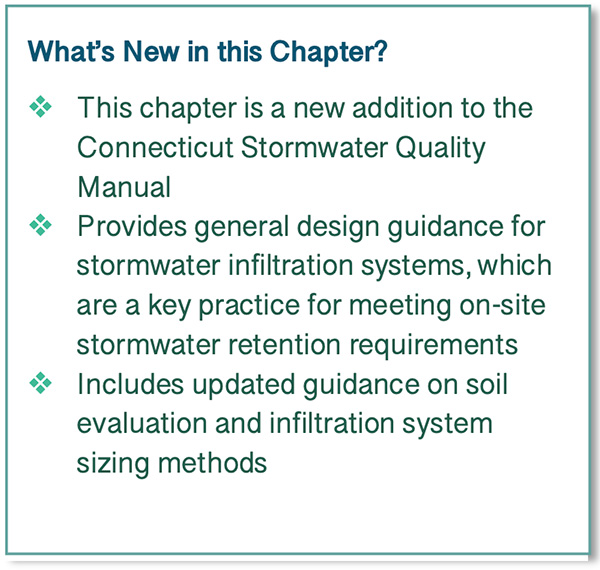Click on the headers for PDF access of these sections of the Manual
Introduction
On-site infiltration of stormwater using LID site planning and design strategies and structural stormwater Best Management Practices (BMPs) is fundamental to preserving pre-development site hydrology, including groundwater recharge, and minimizing stormwater pollutant loads. As described in Chapter 4 - Stormwater Management Standards and Performance Criteria and Chapter 7 - Overview of Structural Stormwater Best Management Practices of this Manual, stormwater infiltration systems are a key practice for meeting the stormwater retention requirements of the runoff volume and pollutant reduction standard (Standard 1). Stormwater infiltration is therefore an important and integral element of stormwater management systems for many types of land development projects. Infiltration-based stormwater BMPs also require careful siting and design for an effective long-term performance.
This chapter provides general guidance on the design of infiltration-based structural stormwater BMPs, including:
- Infiltration BMPs
- Infiltration Trench
- Infiltration Chamber
- Infiltration Basin
- Dry Well
- Infiltrating Catch Basin
- Permeable Pavement
- Filtering BMPs (when designed for infiltration, i.e., unlined)
- Bioretention
- Tree Filter
- Surface Sand Filter
- Water Quality Conveyance BMPs (when designed for infiltration, i.e., unlined)
- Dry Water Quality Swale
The information in this chapter is intended for use with the BMP-specific design guidance in Chapter 13 - Structural Stormwater BMP Design Guidance for stormwater infiltration practices. Chapter 8 - Selection Considerations for Stormwater BMPs provides selection and siting considerations for infiltration systems and other structural stormwater BMPs, while Chapter 9 - Stormwater Retrofits addresses stormwater retrofits including use of infiltration systems to retrofit existing developed sites and drainage systems.
Soil Evaluation Guidance
Soil evaluation is required for all proposed stormwater infiltration systems. This section reviews the followed steps for soil evaluation:
- Initial Screening
- Test Pits and Soil Borings
- Field Infiltration Testing
- Soil Evaluation Documentation
General Design Guidance
Further in-depth guidance on various aspects of design for stormwater BMPS such as soil infiltration rate, design infiltration rate, maximum drain time, slope, contributing drainage area, and more.
Design Infiltration Volume
Information about retaining the design infiltration volume, or the volume of post-development stormwater runoff required to be retained on-site, using stormwater infiltration systems.
Sizing Methods
In-depth information and guidance on the two methods which can be used for sizing an infiltration system to adequately store the design infiltration volume: the Static Method and the Dynamic Method.
